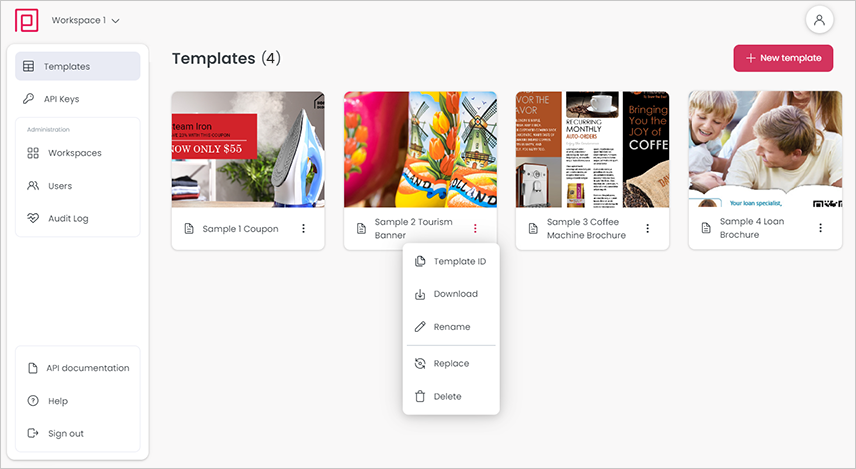Personalia dashboard
Welcome to the Personalia dashboard, the place where you manage your templates, API keys, workspaces, and users.

The dashboard includes sample templates and an API key so your developer can immediately start experimenting with the Personalia API.
Templates
Designers can create templates using the InDesign plugin called uCreate, and upload them to the dashboard using the New Template button. Click the template card to drill in and preview the template. The template menu is used copy the template ID, rename, download, replace or delete the template.
Developers can preview the template, copy the template ID and JSON. Next, they can use it together with the relevant API key and API calls to integrate the template into 3rd party applications.
API keys
Personalia requires an API key which is used for authentication. The API key is created in the API Keys page per workspace and per service. For example, create one API key for content creation and another for the 3D visualizer. Copy the relevant API key and past it into your API call.
If an API key is hacked, delete the compromised API key and create another for the relevant service. Next, replace the API key in your API calls. It’s recommended that you use a different API key for each public use-case (e.g., 2 different websites), because if a key is compromised, it is easier to identify and fix. We strongly recommend that you don’t use the same API key for public (e.g., website) and for private usage (server-side application).
Workspaces
A workspace is a separate and protected area for managing your work in Personalia. It can be used to isolate customers, brands, departments, topics, etc., based on your organization's needs.
Workspaces are created in the workspace page. Templates and API keys are associated to a specific workspace and can’t be moved or shared between them.
Navigate between the workspaces using the arrow to the right of the workspace name (top left corner of the dashboard).
The number of workspaces and templates you can create is based on your subscription plan.
Audit log
The audit log records all events, including production events, preview and API events. Both successful and failed events are listed.
The log is typically used to investigate issues and to resolve conflicts. It contains all relevant details of the API call, which may also contain Personal Identifiable Information (PII). Events are kept for a maximum of 30 days (GDPR compliance).
